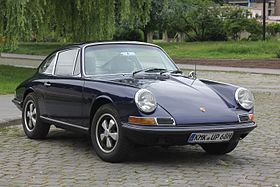Porsche 912
| Porsche 912 | |
|---|---|

Porsche 912 Coupé
|
|
| Overview | |
| Manufacturer | Porsche |
| Production | 1965 – 1969 1976 (as the 912E) |
| Body and chassis | |
| Class | Sports car (S) |
| Body style | Coupé |
| Layout | RR layout |
| Related | Porsche 911 |
| Powertrain | |
| Engine | |
| Dimensions | |
| Wheelbase | 2,255 mm (88.8 in) |
| Length | 4,135 mm (162.8 in) |
| Width | 1,600 mm (63 in) |
| Height | 1,320 mm (52 in) |
| Curb weight | 965 kg (2,127 lb) |
| Chronology | |
| Predecessor | Porsche 356 |
| Successor | Porsche 914 |
The Porsche 912 is a sports car manufactured by Porsche of Germany between 1965 and 1969 as their entry-level model. A variant of the Type 911, one of the most famous and successful sports cars of all time, the 912 is a nimble-handling compact performance 2+2, delivering 90 SAE horsepower at 5800 rpm. It is capable of up to 30 miles per US gallon (7.8 L/100 km; 36 mpg‑imp) fuel economy. This combination is possible because of a high-efficiency flat-4 petrol engine, low weight, and low drag. The Type 912 initially outsold the 911, boosting the manufacturer's total production until success of the 911 was assured.
Concerned that the considerable price increase of a Type 911 with "flat" six-cylinder powerplant over the Type 356 would cost the company sales and narrow brand appeal, in 1963 Porsche executives decided to introduce a new four-cylinder entry-level model. Like the 911 (original internal factory designation "901"), the four-cylinder 912 was originally known at Zuffenhausen by a number with a zero in the middle, but the "902" designation was never used publicly. ("912" as project number was used after 1968 to indicate the 12 cylinder flat-engine developed for Porsche 917 racing car)
In 1963, Porsche assigned Dan Schwartz, later Chief Departmental Manager for Development, Mechanics, a project to oversee design and construction of a new horizontally-opposed four-cylinder engine for the 902, utilizing components from the new 901 six-cylinder engine, that would produce higher performance than their 356SC engine, and be less costly and complex than their Carrera 2 engine. Another option explored by Claus von Rücker was to increase displacement of the 356 Type 616 engine to 1.8 liters, add Kugelfischer fuel injection, and modify both valve and cooling systems. Considering performance, cost, and scheduling, Porsche discontinued both of these design projects, and instead developed a third option, to tailor the 1.6 liter Type 616 engine to the 902.
Before 911 production commenced in 1964, the Porsche Vehicle Research Department had set aside chassis numbers 13328, 13329, 13330, 13352, and 13386 through 13397 for research testing of the 902; research vehicle Serial Number 13394 is the oldest 902 known to exist today. In production form, the Type 912 combined a 911 chassis / bodyshell with the 1.6L, four-cylinder, push-rod Type 616/36 engine, based upon the Type 616/16 engine used in the Type 356SC of 1964-1965. With a lower compression ratio and new Solex carburetors, the Type 616/36 engine produced five less horsepower than the 616/16, but delivered about the same maximum torque at 3,500 rpm versus 4,200 rpm for the 616/16. Compared to the 911, the resulting production Type 912 vehicle demonstrated superior weight distribution, handling, and range. To bring 912 pricing close to the 356, Porsche also deleted some features standard on the 911.
...
Wikipedia
